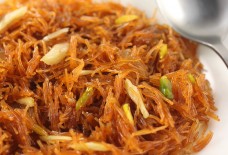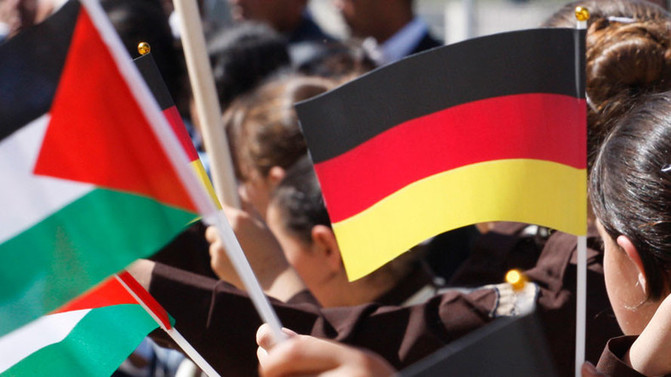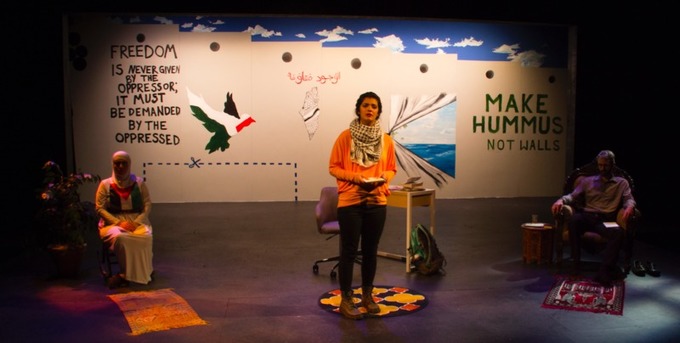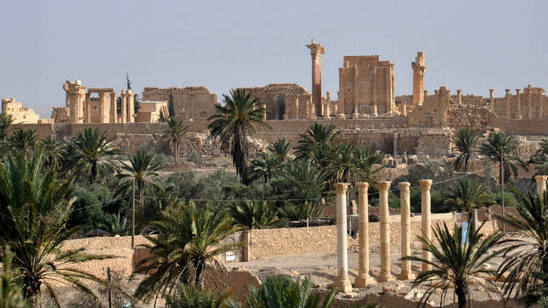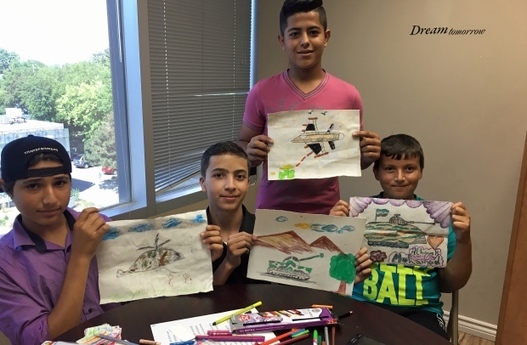
By Libbie Katsev
Pittsburgh Post-Gazette
When artist Thar Sayegh fled Iraq in 1999, he left his home, his possessions, his education and the promise of a bright career teaching art. But moving to Anaheim, Calif., after living as a refugee in Jordan for 14 years, brought a new kind of loss — He had to stop painting.
Mr. Sayegh, who moved to Pittsburgh last fall, lives in Greenfield with his family and works as a driver for Uber and Lyft while taking classes at the Community College of Allegheny County. But before moving to the U.S., he worked for more than a decade to build a successful career as an artist. Now, he’s painting in class and working toward following his calling to again be a full-time artist and art teacher.
“I feel that I have more energy or power when I can do something [with] deep meanings or with a message,” he said.
In his paintings, a man washes himself by a stream, women lean down to harvest wheat, and a whirl of faces surrounds a pair of lovers — their vivid expressions both realistic and blurred by the swirls of color. While working in the Middle East, Mr. Sayegh said, he liked to paint “anything related to humans, to people … to ignore everything else, like nationality, like religions, like traditions.”
Often, he painted simple scenes in daily life, trying to capture moments in the way photographers do.
“I want to show how people are suffering, respect others, sacrifice others,” he said. “How people have love for other people or … the place that [they] belong to, [where] they’re born and raised.”
Mr. Sayegh spent more than a decade developing his technique of using oil paints in such a way that the oil is “light and sensitive” like watercolors.
“I want to do something special in my art. I don’t want to follow the others,” he said. “And I swear, if I couldn’t get anything new I would never show people my art.”
Mr. Sayegh realized he was skilled at art as a young boy when his friends asked him to draw trees, cars and other pictures for them. At first he mostly drew to show off, he said, but it came to be the way he thought and expressed himself.
“Little by little, day by day, it start[ed] to be everything in my life,” he said.
He studied art at the University of Mosul, where he was at the top of his class. There, he met his wife, another talented art student. His teachers were waiting for him to graduate so he could join their ranks, but Iraq was becoming increasingly dangerous. In 1999, when Mr. Sayegh was just one year shy of getting his degree, his family had to flee to Jordan.
It was a “very dangerous and weird” journey, he said. It was illegal for people to leave the country except for short periods if they left money in the bank to ensure their return.
Mr. Sayegh’s family was counting on the fact that his father, a former politician, had a diplomatic passport. But when his father got his passport renewed, he found he no longer had diplomatic travel privileges: There was no guarantee he wouldn’t be recognized, stopped or even jailed. His father went anyway and made it into Jordan without incident.
“I don’t know how he got out,” Mr. Sayegh said. “Nobody knows.”
The rest of the family followed. It was a painful departure — especially for his wife, who cried, saying she couldn’t imagine never seeing her parents or siblings again. Claiming to be going on vacation, Mr. Sayegh took a taxi into Jordan. He never returned.
“We lost everything,” he said. “We lost our home. The government … took everything we own.”
In Jordan, the family went immediately to the U.N., where they received refugee status. That protected them from deportation, but because he was in Jordan illegally, he couldn’t own a home, travel or complete his studies. Despite those hurdles, he attained success as a professional artist after friends connected him with the management of the Orfali Art Gallery, a prestigious private gallery in Amman.
“When they saw my art they said, ‘Wow, that’s what we need. Even if you don’t have certificates, we don’t care,’ ” Mr. Sayegh said.
Orfali gave him a trial period as a teacher and then a full-time job and eventually put him in charge of designing the curriculum. He became known for his work in Iraq and Saudi Arabia and had his work shown in Manhattan with that of other Iraqi refugee artists. And his family grew: He and his wife had four children, who now range in age from 6 to 16.
Then, in 2013, the U.N. told them they were to move to California.
“We had just five days to wrap up everything that we had for 14 years,” Mr. Sayegh said.
In the U.S., Mr. Sayegh was finally legally able to complete his studies. But life in California was a “very tough situation,” he said. At first, he continued to exhibit his art, but he couldn’t find buyers. With a family to support, he had to look for other work.
“It was very hard to start seeking … any kind of job outside of [the] art field,” he said.
Driving required few skills and little English. At the time, he had just started taking English as a second language classes. Although Mr. Sayegh lived in Anaheim, he drove and worked in Los Angeles, 40 minutes away, coming home every three to five days to get some rest. Most of the time, he ate and slept in his car.
“I had to spend all my time and energy just for work. I couldn’t paint or study,” Mr. Sayegh said.
So, a little less than a year ago, he, his wife and children, mother and sister started over for the third time. The family of eight piled into three cars and drove across the country for nine days until they reached Pittsburgh. He chose Pittsburgh for its affordability and proximity to the New York art world, Europe and the Middle East. It’s still too dangerous for his family to visit Iraq, but he hopes to return someday.
“It’s not very easy to start from zero, but now we are happy that we are here and we have this opportunity, and I think I will be successful here,” Mr. Sayegh said.
He and his family like Pittsburgh’s slower pace and high-quality educational institutions. The lower cost of living enabled Mr. Sayegh to enroll at CCAC in the spring. Despite his experience in the field, he needs a degree to teach art. Every time he leaves for class, his wife — who hasn’t been able to paint in years — reminds him how lucky he is and tells him she’s happy for him.
“Through classes I came back to my brushes,” Mr. Sayegh said. “I missed my brushes a lot, been away from them for about 2½ years.”
Mr. Sayegh also finds the city’s natural beauty inspiring. For the time being, though, he’s sticking to class assignments.
“It’s refreshing my mind and my hand to come back to my skills,” he said. “But I’m looking forward to have more time and opportunity to paint.”
He hasn’t had time to make connections in the Pittsburgh art world or find sponsorship to allow him to paint independently.
“[Starting over three times] cost me a lot of time and effort, but I still have determination,” he said. “I’m 46, but I still have determination to continue my study and to obtain my degrees, and to do everything that I ever want to do.”
Source: www.post-gazette.com



